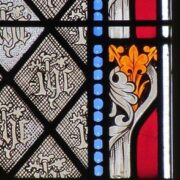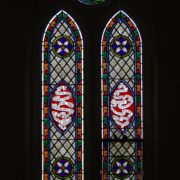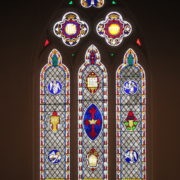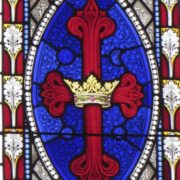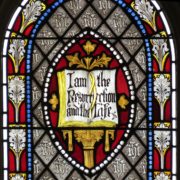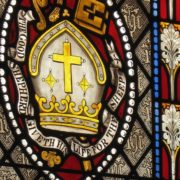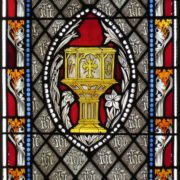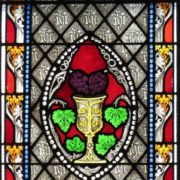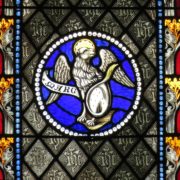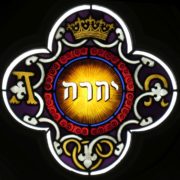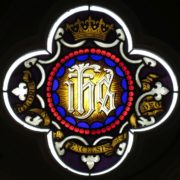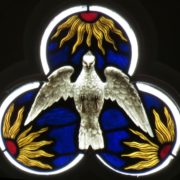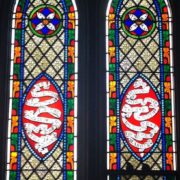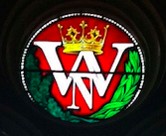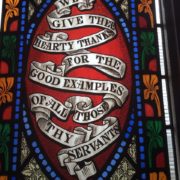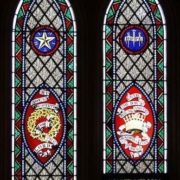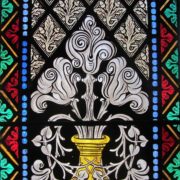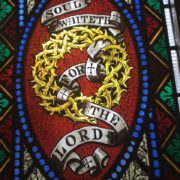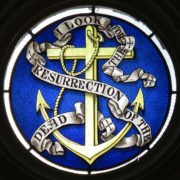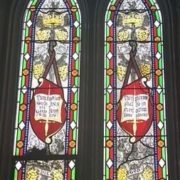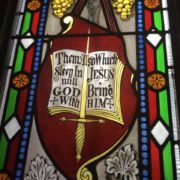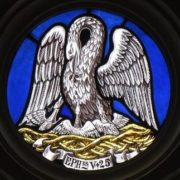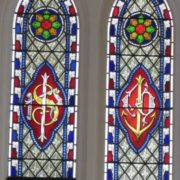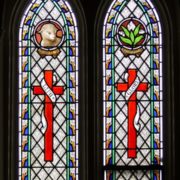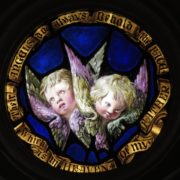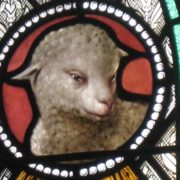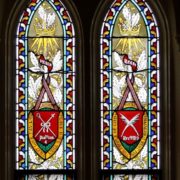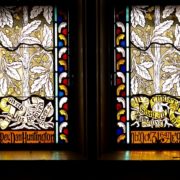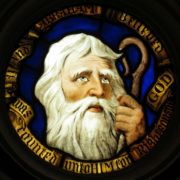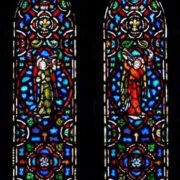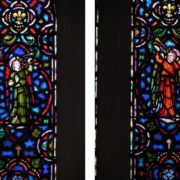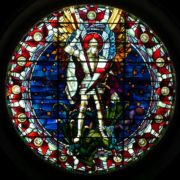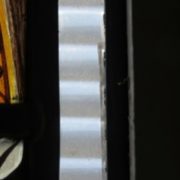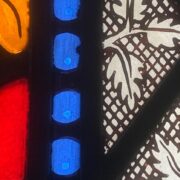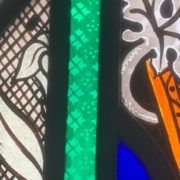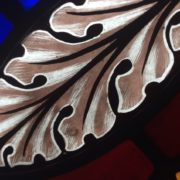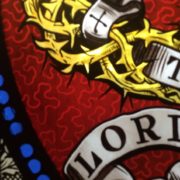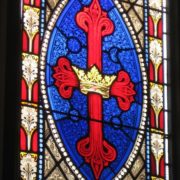Stained Glass Windows at Grace
Grace Church is fortunate that many of its original stained-glass windows, dating from 1866, are still in place. Twenty of them were designed by William Gibson, who emigrated from Edinburgh and opened one of the first stained-glass workshops in America, in New York City, in 1833. Although Gibson was prolific and successful, very few of his windows are known to have survived. Thus, Grace Church may be the best place in the world to see the work of this master, who considered himself “the Father of Stained Glass in America.”
Please click on the thumbnail to see the larger photo.
- Many of these windows are done in grisaille, a technique whose name comes from the French word for gray, “gris.” Look closely at the grayish background, and you’ll see that it is composed of small diamond-shaped panes, each hand-painted in the same design using black, gray, or occasionally white enamel on frosted white glass.
- Set into the grisaille are often medallions in bright blue, red, and other colors, decorated not with scenes of Biblical stories as in many churches, but with symbols of religious significance and with words—often quotations from the Bible. This style of window was commonly employed in English parish churches of the thirteenth century. Since Grace Church’s architecture imitates churches like these, the windows appropriately complement the building. Grisaille serves to screen out some of the outdoor light, but not as much as the deeply colored glass popular in earlier Gothic architecture, particularly in France.
- The large compound window behind the altar describes fundamental Episcopal beliefs in three parallel tall windows with pointed tops (lancets) below and three smaller, lobed panels above.
- At the center of the lancets, in an oval medallion with a bright blue background, is a red cross with a gold crown, symbolizing Jesus’ Crucifixion and Resurrection as King of Heaven. The red-ground medallions radiating from it represent the ways the benefits of Christianity are communicated:
- through the Bible (at top),
- the Church (the bishop’s mitre, at bottom), and the sacraments of
- Baptism (the font, at left) and
- Communion (chalice and grapes, at right).
- Four smaller roundels with blue backgrounds, in the corners, depict the symbols of the four Evangelists, who chronicled Jesus’ life in the New Testament: Matthew (a winged man), Mark (a lion), Luke (an ox) and John (an eagle). Above the lancets are symbols of the Holy Trinity:
- Father (the Hebrew consonants for Yahweh, between Greek letters alpha and omega, signifying the beginning and the end);
- Son (the IHS monogram); and, at the very top,
- the Holy Ghost (a dove and tongues of flame). Grace Church is dedicated to the Holy Spirit, deliverer of Grace; hence its prominent position at the apex.
- The windows along the side-aisles are memorials, dedicated to specific individuals. The symbols and texts in them were carefully chosen to relate to these people’s virtues in life and their loved ones’ hopes for their existence after death. This window in the north aisle, near the altar, is a memorial to William Nash, a former student at Amherst College who died at age 28, having recently become proprietor of a boys’ school in Brooklyn.
- The oculus (round window above the paired lancets) shows his monogram with a crown and laurel leaves, symbolizing victory and eternity (since laurel doesn’t wilt),
- while the text on the ribbon scrolls below emphasizes the fine example he set.
- This window memorializes Susan Davis Phelps, who selflessly devoted her life to looking after two younger brothers with mental deficiencies.
- The vases at the bottom of the lancets hold amaranth, a plant associated with mourning from Greek times onward. The oak leaves and acorns in the grisaille design are symbols of strength, endurance and resurrection.
- The ribbon mottoes entwined with the crown of thorns and crown of heaven stress Susan’s patient wait to rejoin Christ in Heaven, and the words “Faith” and “Hope” above bear out this message.
- The anchor and rope motif in the oculus above is an ancient symbol of Grace.
- Lucy Ann Penniman is memorialized in a window that emphasizes her as a devoted mother. It features heavy bunches of grapes, which represent good works.
- The red shields with swords bear Biblical messages of faith and remembrance.
- The oculus illustrates the “pelican in her piety”: pre-Christian legend relates that a mother pelican, in times of famine, would pierce her own breast to release blood, which she would feed to her young to sustain them—the ultimate in maternal self-sacrifice.
- This window was dedicated by a Mrs. Cutler in gratitude for having recovered from a severe illness. It features elaborate monograms of Christ, who is given credit for the outcome, and ribbon mottoes of gratitude.
- Two memorial windows in the south aisle are also by William Gibson. Perhaps the most moving is this one, dedicated to two toddlers in the Conkey family who died at ages one and two.
- The angels in the oculus may, in fact, be portraits of the children.
- The message of the symbols and citations in the lancets is that Christ, the Good Shepherd, is tenderly looking after the pair in heaven.
- The Rev. Dan Huntington, a Congregational minister, is memorialized in this window, donated by the women of Emmanuel Church, his son Frederick Dan Huntington’s new Episcopal parish in Boston. Frederick Dan was instrumental in the founding of Grace Church. Father and son held strong, but not always congruent, views on religion, but they had reconciled shortly before Dan Huntington died.
- The oak trees in the lancets stand for endurance and strength, especially in adversity. They are loaded with acorns, symbols of potential, rebirth, and immortality. References to peace and tranquility and to the rewards of faith are repeated throughout.
- The oculus depicts the Old Testament prophet Abraham (a rare image of a human being in these windows), whose merit was his faith and trust in God, not necessarily his obedience or adherence to religious rituals. The same was implied of Dan (and also true of his son).
- This window replaces an original Gibson window and is done in a different style. It approximates the pot-glass windows found in early medieval European cathedrals like Chartres. Glass pieces, each of a single, intense dark color, were assembled like a mosaic, to create patterns and scenes, then leaded together. There was very little painting on the glass, so much less detail could be shown than on windows like Gibson’s, which were largely achieved by using multiple colors of vitreous enamel paint on clear or white glass.
- Here, two central ovals enclose trumpet-playing angels. They are surrounded by decorative flowers, foliage, and cross-shapes. If these carry symbolic intent, it is not understood. The window memorializes George Smith Kendrick, an Amherst businessman, and was created in 1931, probably to replace a Gibson place-holder window of 1866. You will note how little light gets through, compared to a Gibson grisaille. Some viewers prefer the jewel-like colors of this type of window.
- The other replacement for an original Gibson window is the enormous circular window in the west wall, over the door into the sanctuary. Its subject is the Archangel Michael slaying the dragon, who represents Evil or Satan. In front of a starry sky, Michael in full armor stands triumphant with a foot on the neck of the beast. He wields a long spear whose tip is covered in the dragon’s blood. Around him is arrayed a ring of 16 seraphs’ heads with red wings. The positive message here, as you leave the church to re-enter the “real world,” is that Good triumphs over Evil. The reason for replacing the original Gibson “rose” window at Grace is not known. This window was made in 1924 by Clayton and Bell of London, a stained-glass workshop famous for the quality of its glass, its excellent designs and prolific output (most of which stayed in England). The company, which began in 1865, remained in business until 1995. Interest in seeing its windows in the US has grown substantially since then—they are found in more than a dozen churches, including several in Massachusetts.
How were they made?
Glass has been known since the second millennium B.C.E. It is formed by heating together silica (usually sand), sodium carbonate (often from wood ash), and calcium oxide (lime). Adding metallic salts or metallic oxides produced colors: cobalt for blue, iron and chromium for green, sulfur or cadmium for yellow, and gold for red. Such glass was known as pot-glass, and by the Middle Ages artisans had learned how to produce fairly thin, flat pieces of it. Pieces could be joined using strips of lead, which allowed larger sheets to be assembled, just about the same time as Gothic-era architects began figuring out how to cut larger window openings into walls without having them collapse.
Pot-glass windows require a new piece of glass every time another color is needed, however. Craftsmen experimented with adding paint to show further detail, such as fingers or facial features, but the paint tended to flake or rub off over time. Glassmakers next came up with the idea of creating a vitreous enamel paint by mixing ground colored glass with a binder like gum-arabic. After the paint dried, the glass was fired a second time. The ground glass melted, the binder was driven off, and the design was permanently fused with the glass substrate. This revolutionized the art of stained-glass, enabling multiple colors to co-exist on a single piece of glass and intricate designs to be executed.
- Master artisans like William Gibson found ways to add sparkle and texture to their painted glass. Gibson regularly bordered his compositions with a narrow band of rippled white glass. There are ripples on both faces of the glass, achieved by putting it through rollers.
- When his design called for a traditional “string-of-pearls” motif, Gibson would emphasize the roundness of the individual “pearls” by removing a small dot of paint from each of them before the paint was fired, allowing the translucent glass beneath to show through the semi-opaque paint layer, creating the effect of a highlight.
- He sometimes added a minute painted pattern to animate a surface,
- scratched away an opaque layer in places to enhance a sense of three-dimensionality, or
- applied a transparent layer, fired it, then added a translucent layer, and scratched a squiggle pattern through the second layer before he fired that, revealing the transparent layer beneath.
- Another form of stickwork was used to create the subtle vine-and-flower motif in the blue background of this window. The windows repay close examination. Two roundels in the entryway to the Connector, adjacent to the sanctuary, are mounted at eye level, making it particularly easy to get close and see (even lightly feel) these effects.
Photographs by Grace parishioners Nancy Lowry, Doug Moore, and Ken Samonds. All Rights Reserved.
The windows richly repay a visit in person, if you are able to make one.
For a more complete description and additional photographs, see Ken Samonds, A Slant of Light: The Stained-Glass Windows of Grace Church (Amherst, MA: Combray House, 2022).

